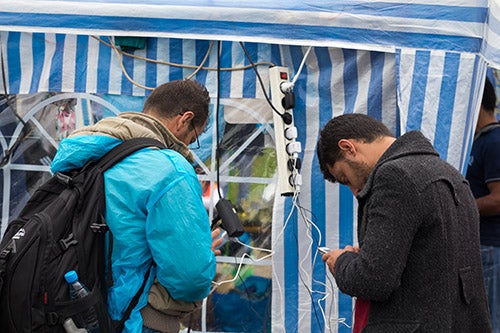 There are currently
66 million people forcibly displaced across the globe, 26 million fleeing their countries as refugees and 40 million internally displaced - the worst such crisis since World War II. The Middle East is among the most affected regions with over half the Syrian population forcibly displaced -
six million as refugees, mostly in neighboring Lebanon (over one million), Jordan (over one million), and Turkey (3.2 million), plus nearly a million asylum seekers in Europe. There are also millions of internally displaced peoples (IDPs) in
Syria (6.3 million),
Iraq (
5.4 million since 2014),
Yemen (2 million), and
over 300,000 in Libya.
There are currently
66 million people forcibly displaced across the globe, 26 million fleeing their countries as refugees and 40 million internally displaced - the worst such crisis since World War II. The Middle East is among the most affected regions with over half the Syrian population forcibly displaced -
six million as refugees, mostly in neighboring Lebanon (over one million), Jordan (over one million), and Turkey (3.2 million), plus nearly a million asylum seekers in Europe. There are also millions of internally displaced peoples (IDPs) in
Syria (6.3 million),
Iraq (
5.4 million since 2014),
Yemen (2 million), and
over 300,000 in Libya.
This massive movement of people has its own economic dynamics with large amounts of government spending, humanitarian and development funds, money flows from refugee livelihoods, as well as illicit trafficking of everything from people to various goods and the growth of criminal enterprises preying on the displaced and on hosting communities. As in all economic activity these days, technology plays a growing role
Cheaper mobiles (including smart ones), internet access, social media, and innumerable apps means that connectivity is increasingly indispensable. According to Mercy Corps, “This is not to say conventional aid like food, water, and medicine isn’t still vital — it is. It just so happens that in this crisis, in particular, technology and information are a powerful and effective means of providing it.”
Indeed, digital tools play a role beyond humanitarian basics like education, health, employment, and dealing with bureaucracies. This means rethinking how to support displaced and host communities.
Keeping track of every relevant app and digital technology is nearly impossible, but one can get an understanding of their most common usages. The GSMA, which represents global mobile operators and companies, groups usage under 5 categories in its “The Importance of Mobile for Refugees” report. These are:
- connectivity, focusing on access, usage and affordability for refugees and IDPs,
- digital tools and platforms, from instant translation apps to many providing broader integration help
- family reconnection tools, such as UNICEF’s RapidFTR and Refugee United’s Refunite services.
- Education, where application developers include Coursera, Google, Microsoft, and Pearson among many others. The University of Massachusetts documents a surge in private sector refugee education programs, with 49% focused on technology – often overwhelming donors and governments.
- Livelihoods and mobile money is a critical area where widespread use of mobile technology is changing how aid is delivered with digital cash transfers, some using Blockchain, which underpins bitcoin and allows for secure IDs. The mobile money ecosystem is not always an option, but more accessible apps focus on employment, housing, and entrepreneurship support.
Large databases from the UNHCR, the EU, and national governments keep track of the forcibly displaced. Technology unfortunately also facilitates illegal activities from human trafficking and smuggling to other organized crime activities. Efforts to police the displaced while strengthening borders are also technologically-intensive.
Drones are another rapidly developing technology. The UNHCR monitors displaced populations and their needs using drones, while drones help monitor and rescue Mediterranean and Aegean asylum seekers. Drones are also used for extending Wi-Fi to refugee camps and displaced populations. Drones will soon be increasingly delivering aid, especially to IDPs who are often more isolated than refugees. With trials of drones carrying people, the days when responders are airlifted in and the injured are evacuated may not be far off.
Simpler, improvised technologies also have a role. Syrian IDPs produce diesel from plastic bags and scraps - boiled for 12 hours in metal and stone ovens, then distilled for transport, generators, etc. Televisions, radios, cell phones and laptops are charged using pedal power. Solar panels abound, some locally manufactured in Syria, as do improvised wind power devices. On solar power, Yemen has forged ahead the most aggressively with solar panels almost ubiquitous, from units powering a few lamps for $20 to powering lights, a washer, and television for $80, as well as solar water filters. This is feeding a new and growing economic sector.
Distributed renewable power systems may also be politically expedient in camps or encampments for the forcibly displaced since traditional power systems could project a politically unacceptable perception of permanence. There are also larger solar power plants such as in Jordan’s Za’atari camp, funded by Germany and serving 80,000 Syrian refugees.
These technologies create new opportunities while changing how humanitarian and development aid is delivered to displaced peoples and to host communities. Access to the internet, to mobiles, and other technologies is becoming an integral part of delivering aid and to support small distributed energy systems and other localized service providers and markets.
All of this requires closer cooperation with the private sector and local actors. Large donor and government bureaucracies will need to become nimbler and more tech savvy as they adjust their policies. This may include enabling greater use of airwaves and air space even as they exert less control over these resources. They will also need a rights based approach ranging from a focus on data confidentiality to ensuring that the most vulnerable who may lack access to these technologies are not excluded.


Join the Conversation